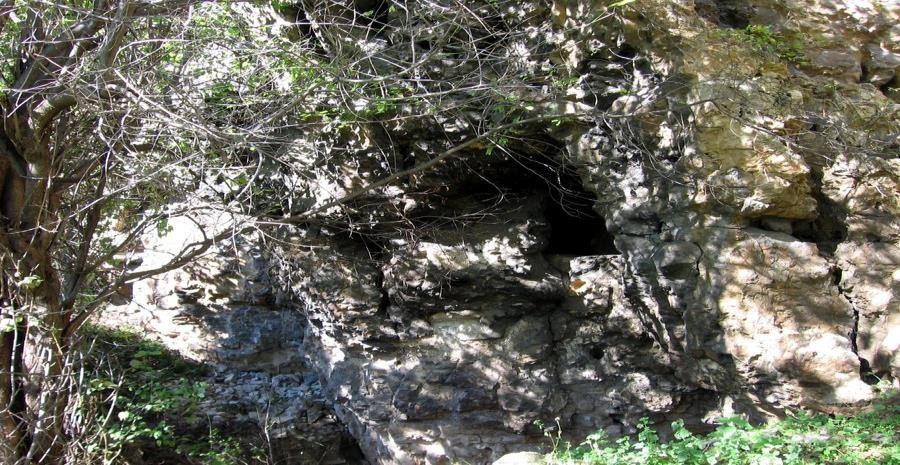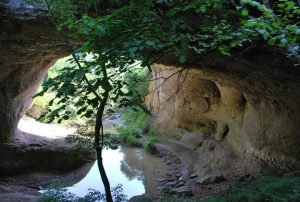

The cave monastery Tsarevets is situated at the southern margin of the village Tsarevets, at approximately 100 – 200 meters on the left border of the Iskar River. In the rocks from the areas of “Govedarnika” and “Kamikul medium” the nature created small caves; they don’t have any name and the locals call them “wholes” and at the north they are rounded and covered with grass. The distance between them is of 100 – 150 meters and they are separated by a small valley similar with a chamfer. “Kamikul medium” is a bit smaller and they are situated at the west from “Govedarnika” and rounded above.
In the southern part of the abrupt ascent “Kamikul medium”, alongside it there are small caves, “the big whole” known under the name of “Biyarnitsata”. The area “Govedarnika” is small in calcareous caves and it is furrowed by caves. In the entire complex of caves there was found graffiti, among which some of them are old inscriptions, others are under the shape of paintings on the rocks with deer hunting, horsemen, birds, monograms, rectangular and other characteristics. Graffiti gives information and an image of the former inhabitants of the caves from the area. Unfortunately some older inscriptions and graving are covered by other later ones, even by some since a couple of decades ago, which destroyed in the most barbaric way the valuable old images, whose content cannot be reestablished.
A part of the rock files were studied by the researchers Michael Mitchev in 1964, which captures and publishes only those inscriptions from the XVIIIth century and which refer to the plague focus “in Zagorje” in the year 1762. Later on, the graffiti from the cave has been also studied by the speleologists Peter Tranteev (the father) and Bojan Tranteev (the son), and in 1972 their studies have been published in periodical magazines. In 1974 M. Michev makes another publication, which is the result of a more fathomed study, in principal connected to the complex of the rock medieval monastery.
The rock alcoves have been declared cultural monument of local importance in the Government Meeting 91 from the year 1979. But after this statute, the complex is forgotten, and recently there are only a couple of visitors and vandals.
The rich content of the graffiti astonishes by its variety of shapes and models, which, in turn, suggests the fact that the inhabitants of this place with many centuries ago, weren’t lacking in imagination and dexterity, and the period in which they stay here is quite long and they are blurred throughout the times.
In a vertical alcove from “Kamika medium” with a thin metallic blade it is inscribed the following inscription: “ASY BROTHER PISAHY KAMITSE KGOI DOHODIHY HRAMY DE M. SANARYT”, which in the modern Bulgarian language means … the brother of Thomas when he came to his temple … The inscription tells us about a monastic name on the name of Thomas, who decided to mark their coming in stone, in the local monastery, and this thing seemed to have been an important event in the monastic life. The short inscription talks about the existence of a church – monastery and an entire complex of rock monasteries. An interesting aspect about the inscription is the fact that the walls of the caves are some of them of black smoke, and the walls are colored. Everything makes you believe the fact that these small caves have been used for accommodation or by the hermits.
Today, from the monastery’s church is nothing left, but it can be supposed where it has been situated. Departing from other monasteries, the church must have been a bigger cave, especially adapted for this purpose. “Kamik medium” served as a temple, of approximately 6 x 4 m and oriented towards the east, situated in the proximity of the agricultural areas from the area.
The name of the location “Govedarnika” and “Pchelinishte” tells us the fact that the monastery has a small farm, which offered the necessary food for the monks.
About the existence of a rupestral church talks another inscription in stone which writes: “SCRII STOYANY GRAMATNIKY WT BESHOVITSA Kogyo OUCHESHE DOUGOVNIKA …. WT M. NASTRA”. The paleographers say the fact that, according to the terms from the inscription, the grammar of Stoyan is relatively later than the one of his brother, Thomas, and by the word “Kogi” we can say the fact that the both of them are from the same area of speaking, Vratsa and Plevensko. The writing which Stoyan left us on the stone is the additional proof that the monastery remained modest in a certain period and fulfilled the role as school church. Important is the fact that the files is mentioned only at the yet undivided Beshovitsa, where at its own turn, it is suggested the fact that it is possible that this inscription to have been sculpted in the last decades of the XIVth century (when the village Beshovitsa wasn’t divided yet). But supposing the fact that author of the writing didn’t succeed in adding the inferior or superior definition, the stone inscription should refer to the end of the XVIth – the XVIIth centuries.
Besides the drawings and the writings in the rocky cave there are met the alcoves of the monastery and the individual names of many recluses. Vpechatlenie is from the left side of the file Stoyan Beshovitsa of intelligently cutting the monogram Dragan – “today Drag” and under two rounds of inscribe crosses (in some antique nationalities it symbolizes the vivid force of the sun).
The exclusive interest is sculpted in one of the caves from “Govedarnika”, the so-called “Shishmanov Sign” – the monogram of the last leader of the Kingdom Tornovo. The appearance of the royal monogram in the rock monastery Tsarevetskiya should be explained by the cloudy years from the end of the XIVth century. It is possible that the sign to be connected to the inscription Bozhenishki, as well as to the popular stories about Shishmans in the village Liutibrod and at the monastery Cherepish.
The curiosity also arouses the geographical proximity of the monastery to the citadel “Bozhenishki Urvich” and Liutibrod (both the places are at approximately 25 km). For now there isn’t any precise information in order to confirm that it took place and for how long they acted from the rupestral accommodation of the tsar, the monogram presence of Shishmanov gives reasons to be supposed the fact that in the XIVth century, the monastery, which is today unknown, had its place in the spiritual Bulgarian space.

